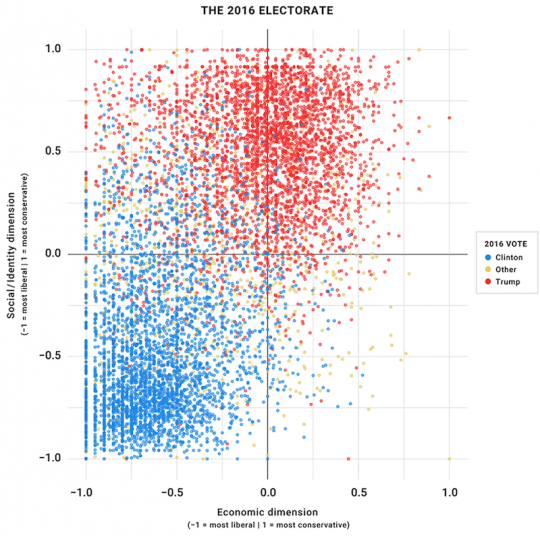The election of 2016 highlighted how politically divided we are as a nation. But the dividing line may not be where we had assumed.
For the past few decades the electorate has been viewed as divided almost equally between social and economic conservatives and social and economic liberals. But a recent study of voting patterns in the 2016 election reveals the old left-right divide is fractured and voters are clustered into four main groups.
The first group is comprised of Liberals, who are liberal on both economic and identity issues. At 44.6 percent, they comprise the largest voting demographic.
The second group is made up of Populists, people who are liberal on economic issues and conservative on identity issues. They are 28.9 percent of the population.
The third group is Conservatives, those who are conservative on both economic and identity issues. They are not only much smaller than the Liberals but even smaller than the Populists, making up only 22.7 percent of voters.
Finally, there are the Libertarians, who are conservative on economic issues and liberal on identity issues. They comprise a mere 3.8 percent of voters.
This scatterplot below shows how these groups aligned in the 2016 electorate.
Not surprisingly, Clinton voters are consistently liberal on both economic and identity issues. But notice that Trump voters are less conservative on identity issues than Clinton voters are liberal. And while Trump voters are clustered around the center-right on economic issues, few are strongly conservative on economics—and many are economically liberal.
Clinton won the majority of Liberals, while Trump won almost all of the Conservatives. But Trump also won 6.3 percent of the Liberal vote and gained the edge in winning over the Populists. Trump beat Clinton by about a 3-to-1 margin among the populists. Clinton won only 5.7 percent of the Populist vote, barely beating out the 4.3 percent of populists who supported third party candidates.
(Libertarians split almost equally between Clinton, Trump, and third party candidates like Johnson, proving that Liberaltarians do exist.)
So how did Trump win? As the report notes, largely by winning over the Populists—liberal on economic issues, conservative on identity issues—who had previously voted for Obama (about 8 percent of Populists had voted for Obama in 2012) or who had supported neither Obama nor Romney in 2012.
He also resonated with those who supported economically liberal positions—which now is the majority of the Republican party. If we look at primary voters, we find that Republicans—even Ted Cruz voters—were to the left of Clinton voters on attitudes about foreign trade. Trump voters were also to the left of every candidate but Kasich on economic inequality.
What does this portend for the GOP? As the report notes,
Republicans are about equally divided between economically liberal populists and more free-market-oriented conservatives. Republican primaries revealed a Kasich faction that is consistently more moderate across issues, a Trump faction that is more liberal on economic issues but more conservative on identity issues, and a Cruz faction that is more free market on economic issues and particularly conservative on moral issues.
[…]
Since Republicans have picked up more economically liberal voters (and may continue to do so since there are still some populists who vote for Democrats), it may be harder for Republicans to continue to push a traditional conservative free-market agenda.
As these results show, free market advocates are completely unwelcome in the Democratic Party and increasingly becoming a minority within the GOP. If we don’t find a way to shift the tide soon we advocates of economic freedom may find ourselves caught between Populist and Liberals as they fight about what sort of socialism we’ll be forced to accept.


